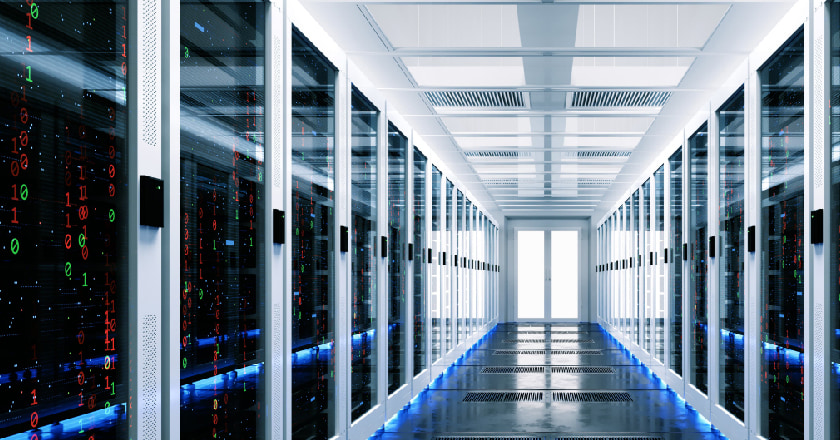
Experts have described data centers as the “backbone of the digital world”. As the global trends for digitization and artificial intelligence continue to surge, the accompanying market demands are expected to remain high. However, data centers have long been infamously associated with high energy density, electricity, and water consumption. Amidst the growing advocacy for ESG, zero-carbon emissions, and sustainable development, data centers are stigmatized as being environmentally unfriendly. The combined carbon emissions of data centers have been estimated to account for 2% of total global emissions, similar to that of the aviation industry. Supporting the needs of the modern digital world and promoting sustainable development – how can data centers balance these two seemingly contradicting roles?
Featured content:
- Evolution of data center development
- What Is the difference between a cloud data center and a data center?
- About SDDC
- Application of cloud data center
- The effect of green data center on the environment
- How to choose a cloud data center supplier?
Evolution of data center development
Data center materialized around 1996 but was initially overlooked, until the rise of the Internet and ISP, ICP, and ASP vendors resulted in a fundamental shift to the digitization of information and communication frameworks, leading to the rapid increase of enterprise demands for data centers. During the initial 2000’s, the Internet industry took a downturn with the burst of the dot-com bubble, and the demands for data centers dropped sharply, putting many vendors out of business.
By 2007, the start of Apple’s iCloud and Amazon’s AWS services introduced the era of the “Cloud” market, which continues to flourish; the popularization of smartphones, social media networks, and audiovisual streaming have integrated cloud computing into a part of daily life. By the year 2015, due to the growing cloud trend, the scale of data centers/cloud service providers become large enough to give rise to new information and communication frameworks. Data centers have taken over from the traditional telecommunication companies, and become the central hubs for all fiber-optic networks, and landing hubs for submarine cables.
With the evolution of digital applications like Big Data, AI, Blockchains, and Metaverse, the computational, storage, and network infrastructures required for these services are mostly cloud-based. As a result, the demands for data centers have grown significantly in these past 5 years as vendors flock to construct and deploy new data centers. However, with the data center market and increasing scale (current data centers are at least 30~50 times larger than those 20 years ago), the energy density has grown 10 times more (from 10~20MW to several hundreds of 10MW), and the construction phase was prolonged 3~4 years, resulting in supply not meeting the overwhelming demands.

What is the difference between a cloud data center and a data center?
The newest generation of data center and the one with the most attention is the “Hyperscale”. While primarily located in Europe and North American regions, in recent 2-3 years, Asian countries with abundant populations and Internet market potentials – for example, Japan, India, China, and Indonesia – have begun to construct Hyperscale data centers as well.
Hyperscale refers to data centers containing several hundreds of thousands to millions of servers, the majority of each are owned by Internet giants like AWS, Microsoft, and Google. Compared to a conventional data center, a Hyperscale data center is much larger in scale and more power-hungry. In an effort to reduce PUE (Power Usage Effectiveness) of data center operations, vendors have been introducing thermal management technologies such as liquid-cooling or immersion cooling, as well as investing billions into green power generation and storage solutions. However, this has also significantly increased the costs of maintenance and operation.
About SDDC
The exterior “shell” of a data center is largely comprised of limited physical elements like concretes, steel rebar frameworks, and electrical power. But the quality of a data center depends on maximizing IT resources through efficient utilization of software technology.An SDDC (Software-Defined Data Center) is also known as a VDC (Virtual Data Center).
It is a data storage facility in which all infrastructure elements such as networking, storage, CPU, and security are virtualized and delivered as a service. The term “SDx (Software-Defined Everything)” has become one of the hot terms in the IT industry. It integrated all hardware components and helped shaped the concepts of virtualization, SDS (Software-Defined Storage), SDN (Software-Defined Networking), and SDDC (Software-Defined Data Center).
Application of cloud data center
The cloud is akin to a large data center at a scale of tens to hundreds of MW, containing large amounts of servers, networking equipment, and storage devices that are linked together via high-speed optical networks, providing various services to a large number of users.
The application of cloud data center has developed to encompass anything that is implemented with computers and networks, such as smart cities, smart appliances, streaming services, metaverse, crypto-mining, e-sport, blockchains, etc. Until quantum computing technology has matured enough for commercialization, it is expected that cloud computing will continue to drive applications and services that human lifestyles and work rely on for the next 30 to 50 years. Virtualization also plays an important role in the future green data center.
The effect of green data center on the environment
Growing environmental awareness has driven the ESG trend; leading three public cloud service providers, such as AWS, Microsoft, and Google, have announced their plans to utilize 100% renewable energy and transition to zero carbon emission, while also offering services such as carbon footprint calculation and emission dashboard to help enterprises that use cloud resources to disclose their own carbon footprints and achieve carbon and energy reduction targets.
In other words, it is hoped that through a diffusion effect, vendors of green data centers can shoulder sustainable responsibilities together with the customers. As global digitization continues, data center operators can help to mitigate and control the growing energy consumption and carbon emission trends through optimized management of water resources and power usage.

How to choose a cloud data center supplier?
The make-up of an enterprise cloud may be influenced by variables such as time, budget, and business growth demands. From the most common IaaS (Infrastructure as a Service), the enterprise may also require services such as SaaS (Software as a Service), Co-location, Web Hosting, Bare Metal, etc. eASPNet is one of the few vendors that can accommodate all these different service types, maintaining cloud data centers in Taiwan, Thailand and the Netherlands. We can also build and manage cloud platforms, with firm grasp operational elements such as accounting, system monitoring, and cybersecurity. We offer one-stop IT planning services like no others and pride ourselves as the premium cloud-based data center provider to address the transformation needs of today’s enterprises.
- Learn More: Green Data Center
- Customer Service Contacts: Live Chat Support





